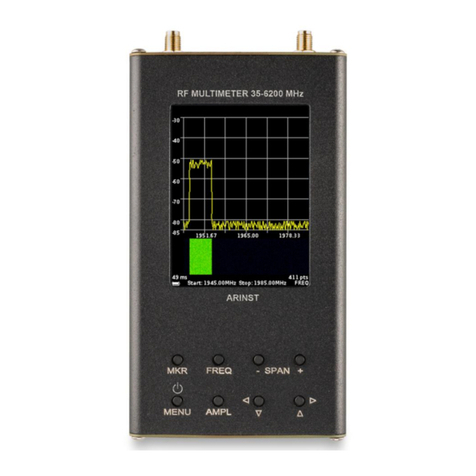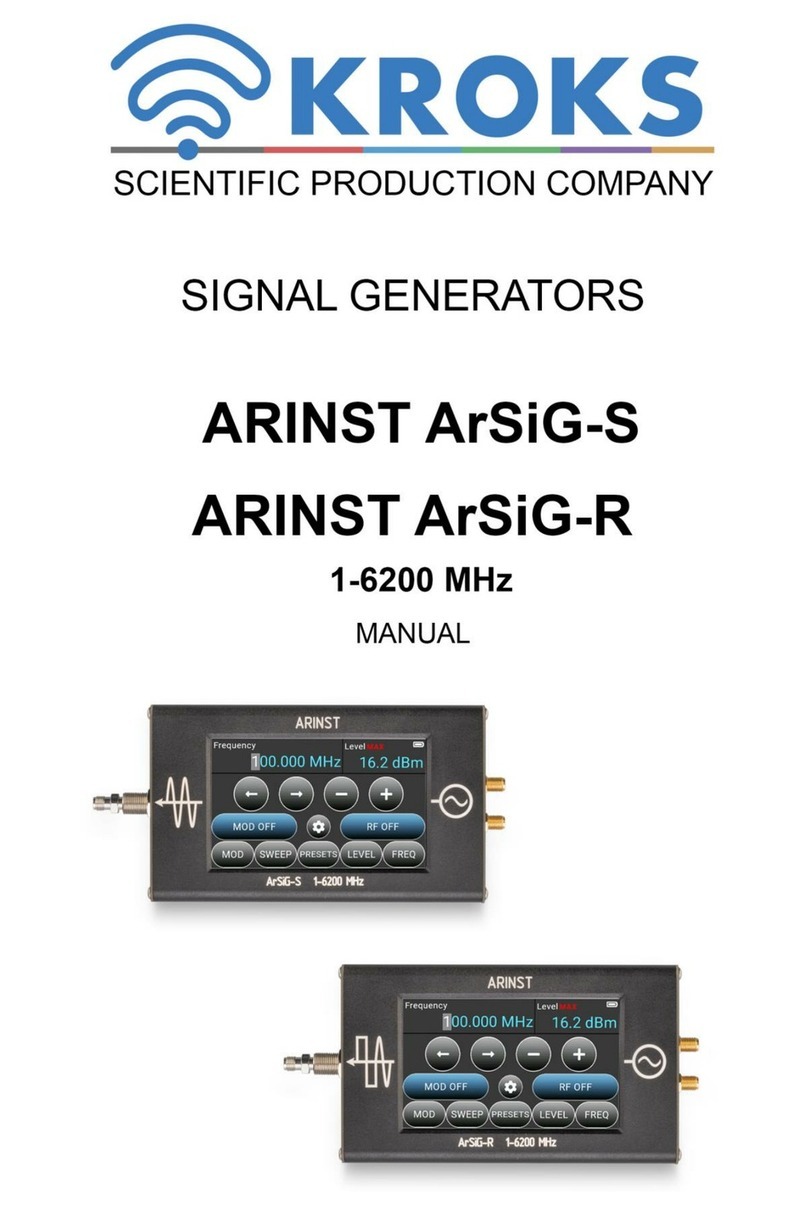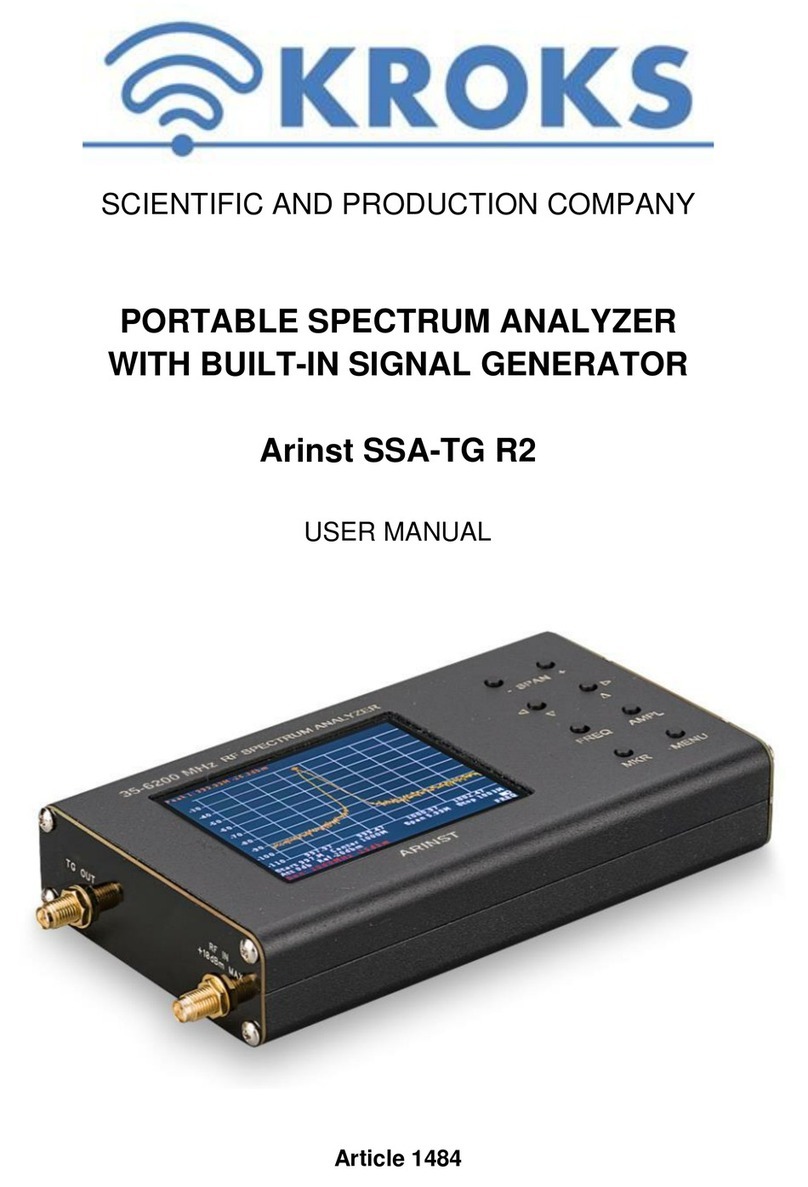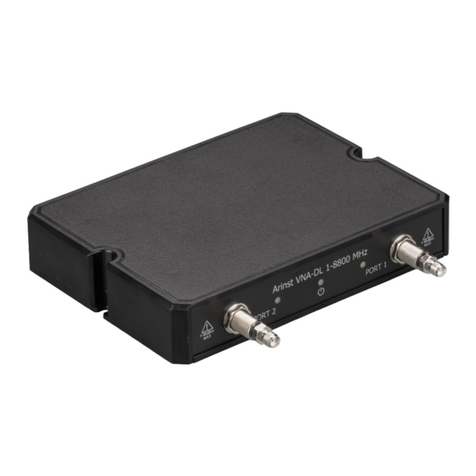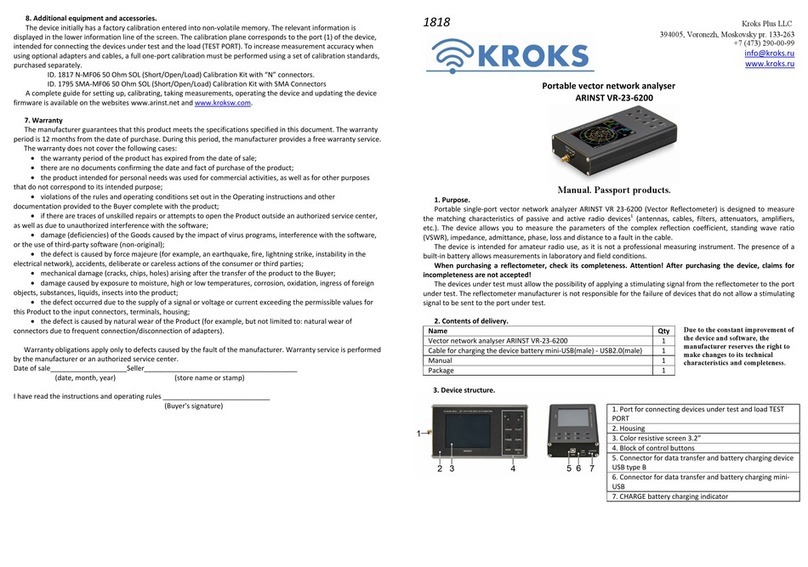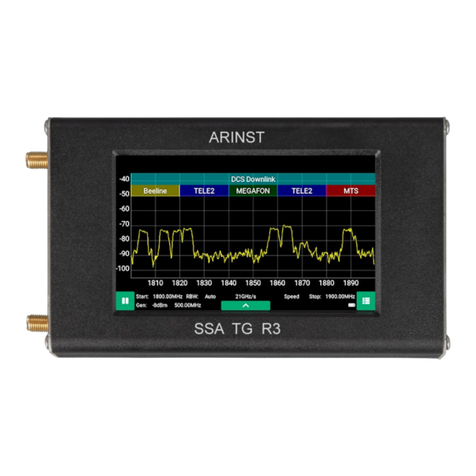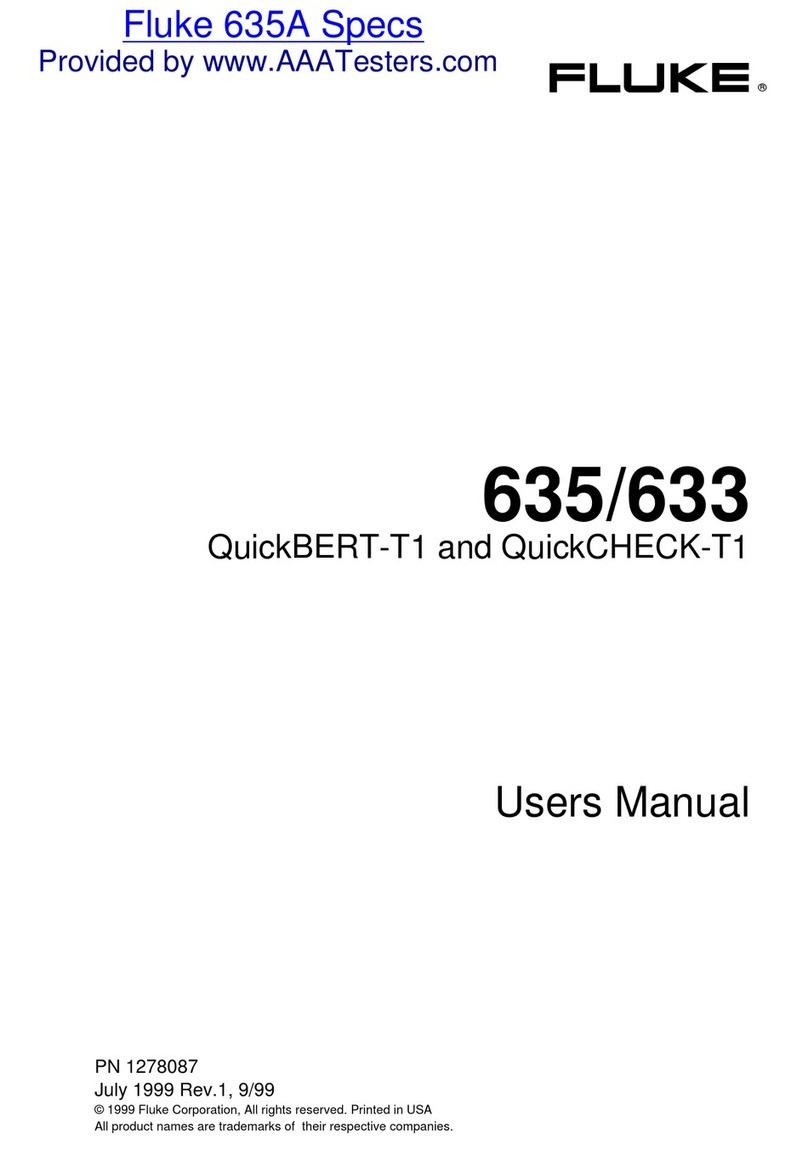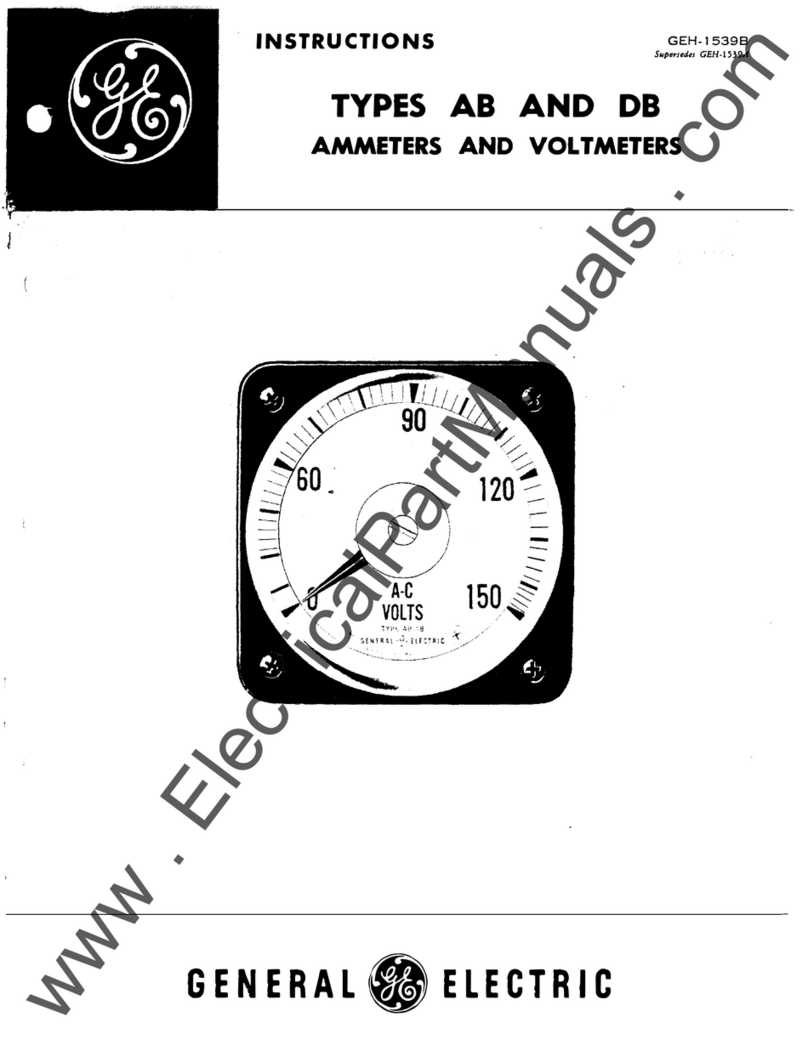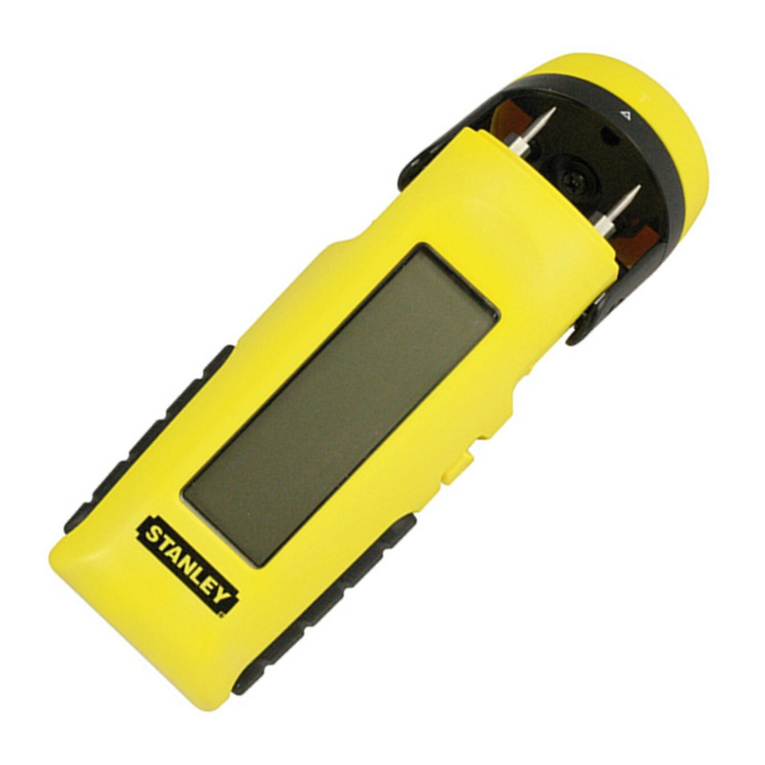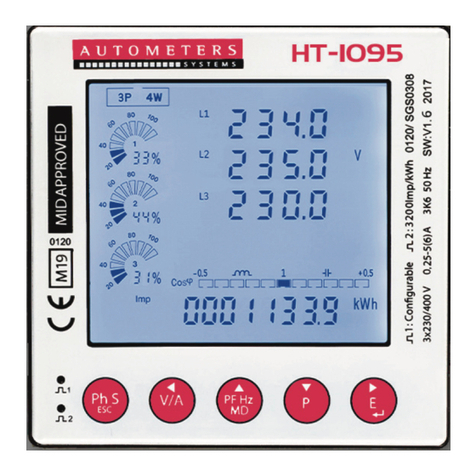Kroks ARINST VNA-PR1 User manual


2-port vector network analyzer ARINST VNA-PR1
2
CONTENT
1. PURPOSE ...................................................................................................................................... 4
2. SAFETY RULES FOR WORKINGWITH THE DEVICE ....................................................................... 4
2.1. General safety requirements......................................................................................................... 4
2.2. Additional safety requirements...................................................................................................... 4
3. SPECIFICATIONS.............................................................................................................................. 5
4. COMPLETENESS............................................................................................................................... 6
5. STRUCTURE OF THE DEVICE.......................................................................................................... 6
6. DESCRIPTION AND OPERATION OF THE DEVICE.......................................................................... 7
7. START ON.......................................................................................................................................... 9
8. SCREEN INTERFACE........................................................................................................................ 9
9. DEVICE MENU................................................................................................................................. 11
9.1. Main menu................................................................................................................................. 11
9.2. Setting the frequency range parameters..................................................................................... 11
9.3. Setting parameters for measuring distance to fault...................................................................... 13
9.4. Device calibration menu ............................................................................................................. 15
9.5. Information about the device....................................................................................................... 17
9.6. Compensation electrical length of the cable................................................................................ 17
9.7. Shift of the amplitude scale on plots Lin. Amp and Log. Amp ...................................................... 19
9.8. Adjusting the output power of the probe signal generator............................................................ 20
9.9. Displaying the SWR limit line...................................................................................................... 20
9.10. Configuring plot parameters...................................................................................................... 20
9.12. User settings menu................................................................................................................... 25
9.13. Saving measurement results..................................................................................................... 26
10. CHARTS AND PLOTS .................................................................................................................... 29
10.1. Smith chart............................................................................................................................... 29
10.2. Polar chart................................................................................................................................ 29
10.3. Phase plot................................................................................................................................ 30
10.4. Plot of the magnitude (modulus) of the reflection coefficient on a linear scale............................ 31
10.5. Plot of the magnitude (modulus) of the reflection coefficient on a logarithmic scale ................... 31
10.6. VSWR plot................................................................................................................................ 32
10.7. Measuring the distance to fault................................................................................................. 32
10.8. Cable loss plot.......................................................................................................................... 33
10.9. Group delay plot....................................................................................................................... 34
11. CARE AND MAINTENANCE........................................................................................................... 36
11.1. General care of the device........................................................................................................ 36
11.2. Battery charging....................................................................................................................... 36
11.3. Battery replacement ................................................................................................................. 36
11.4. Keeping.................................................................................................................................... 38
11.6. Limit state criterion ................................................................................................................... 38
11.7. Utilization ................................................................................................................................. 38
12. POSSIBLE MALFUNCTIONS AND METHODS OF THEIR ELIMINATION....................................... 39

2-port vector network analyzer ARINST VNA-PR1
3
13. RETURN THE DEVICE TO FACTORY SETTINGS......................................................................... 40
14. WARRANTY ................................................................................................................................... 41
APPLICATION A. ARINST VNA-PR1 vector network analyzer software update..................................... 42

2-port vector network analyzer ARINST VNA-PR1
4
1. PURPOSE
1.1. Portable 2-port vector network analyzer ARINST VNA-PR1 (analyzer, device) is designed to
measure the elements of the scattering matrix (complex reflection and transmission coefficients) of four-
port networks. The device measures parameters S11 and S21, voltage standing wave ratio (VSWR), im-
pedance, admittance, phase, group delay (GD), distance to cable fault.
1.2. The analyzer is designed for setting and matching the characteristics of passive and active radio
devices
1
(antennas, cables, filters, attenuators, amplifiers), checking the integrity of high-frequency ca-
bles, measuring their parameters, and other amateur radio measurements.
1.3. The device is intended for amateur radio applications, as it is not a professional measuring instru-
ment. The built-in battery allows you to make measurements in the laboratory and in the practical condi-
tions.
2. SAFETY RULES FOR WORKING WITH THE DEVICE
2.1. General safety requirements
2.1.1. Persons who have read this «Manual»and have been instructed in the rules of safe work with
electrical appliances are allowed to work with the device.
2.1.2. The risk of injury is possible when the charger is connected or disconnected from the electrical
network. Use serviceable power outlets and chargers.
2.1.3. To avoid damage to the wires and connectors of the device, do not hang anything on the wires,
paint over and glue the wires and connectors, disconnect the wires by pulling the cord.
2.1.4. Persons using the device are strictly prohibited: pass the device to strangers, disassemble and
carry out any repairs not agreed with the manufacturer, use a device with a damaged case.
2.1.5. If you find a fault, stop operation immediately and turn off the device.
2.1.6. If you need to leave your workplace, turn off the device and other devices. Do not leave the
working device unattended!
2.1.7. Do not use the device in hospitals. The use of the device near medical equipment is allowed on-
ly with the consent of the medical staff.
2.2. Additional safety requirements
2.2.1. Use the device only for its intended purpose. Read the purpose, device, and technical character-
istics of the device.
2.2.2. Avoid working in open spaces during snow or rain. High humidity and all types of liquid, getting
inside the device, can damage it.
2.2.3. Do not expose the device to very low or very high temperatures, exposure to extreme tempera-
tures can damage the built-in battery.
2.2.4. Do not use the device in areas with a corrosive or explosive environment. Aggressive vapors
can destroy the insulation, which can cause the device to fail.
2.2.5. Do not apply excessive force to the device's connectors, controls, or screen. Avoid bumps and
falls on the device. If the device falls, it may be damaged.
2.2.6. Do not disassemble or modify the device without the consent of the manufacturer or without the
instructions described in this manual. Incorrect self-intervention in the device will result in loss of warran-
ty.2.2.7. Use chargers, cords, adapters, and other accessories recommended by the manufacturer.
2.2.8. When connecting other tools to the device, carefully read their purpose, technical characteris-
tics. Do not connect incompatible devices.
2.2.9. Maintenance and repair of the device must only be performed by the manufacturer or an author-
ized service center.
1
The devices must allow the possibility of applying a stimulating signal from the analyzer to the test port. The analyz-
er manufacturer is not responsible for the failure of devices that do not allow the supply of a stimulating signal to the
test port.

2-port vector network analyzer ARINST VNA-PR1
5
3. SPECIFICATIONS
3.1. The technical characteristics of the device are shown in Table 1.
Table 1
Parameter
Value
Operating frequency range
1-6200 MHz
Frequency resolution
for range 1-100 MHz
100 Hz
for range 100-6200 MHz
10 kHz
Maximum number of scan points
1000
Scanning rate
1000 points / s
Dynamic
range S21
(BW = 250 Hz)
for range 1-1,5 MHz
> 60 dB, 70 dB (typ.)
for range 1,5-4500 MHz
> 80 dB, 90 dB (typ.)
for range -6200 MHz
> 70 dB, 75 dB (typ.)
The direction of the bridge, uncorrected throughout the range,
not less
12 dB
Directivity effective2(after full one-port calibration), not less
55 dB
Input standing wave ratio, not more
2
Phase measurement error2, not more
0,7°
Magnitude measurement error2, not more
0,25 dB
Resolution for determining the distance to fault3
(C × VF)/2S m
Maximum length of the measured cable4, when VF=1
3000 m
Compensation electrical length of the cable, when VF=1
±3 m
Maximum DC Input Voltage
25 V
Maximum input power supplied to the ports
+10 dBm
Maximum power of the probing signal 5, not more
-5 dBm
Displayed charts
■Smith chart; ■ polar chart; ■ phase of the reflection coefficient S11 and trans-
mission coefficient S21; ■ magnitude of S11 and S21 ; ■ logarithmic magnitude of
S11 and S21; ■ SWR; ■ distance to fault; ■ cable loss; ■ group delay
Number of user settings to save
32
Number of traces to save
32
Operating temperature range
0 … +40°C
Screen diagonal
4”
Screen type
touch resistive
Screen resolution
800×480
Test port connectors type
SMA (female)
Maximum current
consumption, no
more
when charging the battery
≤ 2 A6
when working on battery power
~ 1 A
when working from USB with battery charging7
≤ 2 A6
Battery capacity
5000 mAh
Time of continuous battery life8
2,5 h
Battery charge time6
~ 3,5 h
Overall dimensions (L × W × H)
150×81×27 mm
Weight
0,4 kg
2
The measurement is performed after warming up the device for at least five minutes with a full calibration. The
change in ambient temperature from the moment of calibration to measurements should not exceed ± 3 ° С.
3
Where Cis the speed of light m/s; VF –velocity factor (the ratio of the speed of propagation of electromagnetic
waves in the cable to the speed of propagation of electromagnetic waves in a vacuum), takes a value from 0.1 to 1
(depending on cable); S- scanning frequency range (Hz).
4
Depends on the amount of attenuation in the cable and is the indication limit on the display.
5
With the possibility of reducing.
6
When connecting the device to a charger with an output current of at least 3A.
7
If your PC has a limit on the maximum current supplied to the USB port, the device will automatically limit the maxi-
mum charging current according to the current USB specification.
8
At an ambient temperature of 20±5°C after the battery is fully charged.

2-port vector network analyzer ARINST VNA-PR1
6
4. COMPLETENESS
4.1. The delivery set of the device is shown in Table 2.
Table 2
Name
Quantity
The vector network analyzer ARINST VNA-PR1 1-6200 MHz
1 pc.
USB 2.0 –Mini-USB cable
1 pc.
SMA (female) –SMA (female) adapter
2 pc.
Manual (product passport)
1 pc.
Package
1 pc.
Due to the continuous improvement of the device and software, the manufacturer reserves the
right to make changes to its technical characteristics and completeness.
5. STRUCTURE OF THE DEVICE
5.1. The device structure is shown in Figure 5.1.
Figure 5.1 - External view of the device
1. Measuring port 1 (PORT 1) is intended for connecting the test devices and acts as a source and
receiver of the signal.
2. Measuring port 2 (PORT 2) is intended for connecting the test devices and is a signal receiver.
3. High frequency connector panel
4. Color resistive screen 4”serves to configure the device through the on-screen menu and display
measurement results in the form of user-defined plots and charts.
5. Indication panel
6. Multi-function button. Turns on and off the device when pressed and held for more than 2 se-
conds. When pressed once, it opens or hides the main menu of the device.
7. Indicator STATUS. Lights up when the device is on.
8. Battery charging indicator CHARGE. Lights up when the battery is charging and when the device
is operating from USB. Turns off when charging is complete.
9. Connector Mini-USB. Serves for data transmission and battery charging of the device.

2-port vector network analyzer ARINST VNA-PR1
7
6. DESCRIPTION AND OPERATION OF THE DEVICE
Vector network analyzer ARINST VNA-PR1 is a technically complex measuring device consisting of a
test (probe) signal generator, directional couplers, a multichannel receiver, ADC, a microcontroller, LCD
and a Li-Ion battery.
Figure 6.1 - Block diagram of the ARINST VNA-PR1
This is a portable device consisting of the main unit and its accessories (measuring cables, connect-
ors, adapters, calibration tools).
The analyzer performs the functions of forming a probing signal, measuring, calculating and displaying
the measured parameters of the test device.
The analyzer provides adjustment of the output power level of the probing signal generator. Power ad-
justment extends the measurement capabilities of active devices and reduces the probability of exceeding
the maximum power of the input signal of the P2 port specified in the technical characteristics of the de-
vice.
where,
ARINST VNA-PR1–network analyzer;
DUT –device under test;
Р1and Р2–port 1 and port 2 of the ana-
lyzer;
Urwa –reflected wave amplitude;
Uiwa –incident wave amplitude;
Utwa –transmitted wave amplitude.
Figure 6.2 - Schematic diagram of measurements of the
reflection and transmission coefficient
The device generates a probing signal based on the frequency range set by the user.

2-port vector network analyzer ARINST VNA-PR1
8
In measurement mode S11 the probing signal (incident wave) is sent to the first port P1, to which the
test device or calibration standards are connected. A reflected wave is formed, which is separated by a
directional coupler and enters the reflected signal receiver. From the output of the receiver, the intermedi-
ate frequency (IF) signal is converted into digital form using a high-speed ADC. The digitized data con-
tains information about the amplitude and phase of the reflected signal. Similarly, information about the
amplitude and phase of the incident signal is obtained.
At each frequency, the IF signal of the direct and reflected waves is sampled with further calculation of
the amplitude and phase of each signal using the maximum likelihood method.
The obtained values make it possible to calculate the reflection coefficient (RC), which is a complex
number that carries information about both the phase and the amplitude of the reflected and incident
waves.
where, Urwa –Reflected wave amplitude;
Uiwa –Incident wave amplitude;
Φrwp –Reflected wave phase;
Φiwp –Incident wave phase;
j –√-1 –Imaginary unit.
In measurement mode S21 the probing signal (incident wave) is sent to the first port P1. The test de-
vice is connected to port P1 on one side and to port P2 on the other. In this mode, the analyzer can simul-
taneously measure the parameters S11 (according to the algorithm described above) and S21. When
measuring S21, the incident wave passes through the test device, the resulting signal enters port P2 and
enters the processing path of the transmitted signal, is transferred to IF and converted to digital form us-
ing an ADC.
The obtained values make it possible to calculate the transmission coefficient (TC), which is a complex
number that carries information about both the phase and the amplitude of the transmitted wave.
where, Utwa –Transmitted wave amplitude;
Uiwa –Incident wave amplitude;
φtwp –Transmitted wave phase;
φiwp –Incident wave phase;
j –√-1 –Imaginary unit.
After calculating the RC and TC, the microcontroller displays the result of scanning over the frequen-
cy range in the form of plots and charts selected by the user: Smith chart, phase chart, magnitude plot of
RC / TC, SWR plot and others.

2-port vector network analyzer ARINST VNA-PR1
9
7. START ON
Do not use the device outdoors during snowfall or rain. If the device is brought in during
the cold season from a cold room or from the street into a warm room, do not turn it on for
enough time to allow condensation to evaporate from the device.
Match the signal strength and voltage applied to ports P1 and P2 to the maximum device
specifications shown in Table 1.
7.1. Make sure that the device is not damaged externally and that the battery is charged. Charge the
discharged battery in accordance with item 11.2.
7.2. Press and hold button (6) for 2 seconds. The device turns on. When the device is turned on for the
first time, it is necessary to set the frequency range, the type of plots displayed on the screen (4) and car-
ry out calibration. User settings will be saved in the device memory and will be automatically installed on
subsequent switching on.
7.3. To turn off the device, press and hold the button (6) for 2 seconds. The display (4) of the device
will go out, the device will turn off. Each time the device is turned off, the main user settings are recorded
in the nonvolatile memory, which allows avoiding the device setting at the next turn on.
8. SCREEN INTERFACE
The device displays the results of scanning the frequency range specified by the user in the form of
plots and charts. The current device settings and interactive buttons for controlling the device interface
are located at the bottom of the screen.
Figure 8.1 - Device screen
8.1. The information bar of the screen displays information about the current state of the device.
8.1.1. Built-in battery status indicator:
indicator in the form of a spark (lightning) –the battery is charging;
the battery indicator symbol is completely filled in white –the battery is fully charged;
indicator symbol in the form of a white battery outline –the battery is low and needs to be
charged;
the device displays a message about the critical charge level –the battery is fully discharged,
the device will automatically turn off.
8.1.2. Frequency range:
• Numerical values of the beginning and end of the frequency range. In our example, the
frequency range is 1-6200 MHz.
In the mode of measuring the distance to fault, instead of the frequency range, the distance in me-
ters or time in nanoseconds is displayed.
8.1.3. Measurement mode:
S11 –the mode of measuring the reflection coefficient, cable loss and distance to damage;

2-port vector network analyzer ARINST VNA-PR1
10
S21 –transmission coefficient measurement mode.
8.1.4. Calibration type designation:
Factory –factory calibration;
SOL –one-port calibration;
SOL+T –full two-port calibration;
Т–direct connection.
8.2. The interface control buttons are located under the information bar (figure 8.1):
8.2.1. The «pause»button. Pressing the button pauses the measurement process and «freezes»the
plot on the screen. Pressing the button again resumes the measurement process.
–pause off, measurement in progress;
–pause on, measurement is paused.
8.2.2. Buttons for switching charts. The device screen displays buttons for quick access to four plots
with measurement results simultaneously. The chart types and their order in the row are set by the user.
–Smith chart or impedance chart;
–polar chart;
–the phase plot of the measured S-parameter, presented in the range from -180 to +
180⁰;
–S-parameter modulus (amplitude) plot on a linear scale;
–S-parameter modulus (amplitude) plot in logarithmic scale (in dB);
–voltage standing wave ratio (VSWR) plot;
–plot showing the distance to fault or discontinuity in the cable;
–plot of signal attenuation in the cable;
–group delay plot.
8.2.3. Function buttons
–expands the plot to the full screen.
–turn off the plot to access additional settings
–opens access to settings for plots and measurement modes displayed on the
screen.

2-port vector network analyzer ARINST VNA-PR1
11
9. DEVICE MENU
9.1. Main menu
9.1.1. Turn on the device. There are two ways to open the main menu:
Press the button (6) once;
Double-tap the screen.
The main menu will be displayed on the screen, as in Figure 9.1.
Figure 9.1 - Main menu of the device
9.1.2. Each of the sections of the main menu has its own purpose:
Scan –a section of the menu in which the user sets the frequency range for the test device.
Calibration –menu section for performing calibration.
Device –this section sets the electrical cable length compensation, the SWR limit line, the amplitude
scale shift, and the output power level. This section contains the device's serial number and software ver-
sion.
Presets –section for saving user settings.
Traces –section for saving the results of current measurements (traces) with the subsequent possibil-
ity of loading them and comparing them with the current measurement results.
9.1.3. To exit the main menu, press the button (6) once or double-tap the screen next to the plot.
9.2. Setting the frequency range parameters
The frequency range contains the number of parameters by which the synthesizer is rebuilt and the
measurement mode is set (frequency range, number of measurement points, bandwidth of the digital IF
filter).
Figure 9.2 - Menu for setting scan parameters

2-port vector network analyzer ARINST VNA-PR1
12
9.2.1. Enter the Scan section of the main menu of the device. Menu for setting the parameters of the
frequency range Scan is shown in Figure 9.2
9.2.2. Scan menu buttons:
Center –setting the center frequency of the scanning range.
Span –scanning range of frequencies.
Start –setting the initial frequency of the scanned frequency range.
Stop –setting the final frequency of the scanned frequency range.
BW –selection of the bandwidth of the digital IF filter.
Points –selecting the number of scan points.
DTF range settings –setting the parameters of the horizontal scale of the DTF plot. Switching to the
time or distance settings of the DTF plot.
Back –exit to the main menu.
9.2.3. The frequency parameters Center, Span, Start and Stop are set by entering a numerical value
in the opened submenu, as shown in Figure 9.3. The resolution of setting the frequency parameters is
100 Hz in the frequency range up to 100 MHz and 10 kHz in the range from 100 to 6200 MHz. Enter the
numerical value of the frequencies in MHz or GHz and press the corresponding button. To delete incor-
rect or previously entered values, press <(Delete). Press ×(Cancel) to exit the menu without entering
values.
Figure 9.3 - Entering numerical values of frequency parameters
9.2.4. There are three ways to set frequency parameters:
By entering the initial Start and final Stop frequencies, the center frequency Center is automati-
cally assumed to be equal to their half-sum. The Span frequency range is automatically set
equal to the difference between the final and initial frequencies.
Setting the Center frequency and the frequency range of scanning Span. In this case, the Start
and Stop frequencies will be set automatically as Center ± Span / 2.
Loading custom settings from the Presets menu.
If the frequency entered by the user is outside the operating range, a warning is displayed on the
screen.
9.2.5. In the BW menu (figure 9.4), the bandwidth of the digital IF filter is selected. The narrower the
bandwidth of the digital filter, the higher the signal-to-noise ratio and, consequently, the higher the meas-
urement accuracy. As the bandwidth decreases, the scan time increases.
Reducing (narrowing) the bandwidth by 10 times will lead to an increase in the voltage signal-to-noise
ratio by 3 times (or 10 dB) with an increase in scan time by 10 times.

2-port vector network analyzer ARINST VNA-PR1
13
Figure 9.4 - Bandwidth selection in the BW menu
9.2.6. In the Points menu (figure 9.5), select the number of scan points. The frequency step and scan
time depend on the set number of points. The correct selection of the number of points and the scanning
range allows you to improve the resolution of measurements in the DTF and Cable Loss plots.
Figure 9.5 - Points, menu for selecting scan points
9.3. Setting parameters for measuring distance to fault
9.3.1. Enter the Scan section of the main menu of the device. Set the parameters of the frequency
range in accordance with unit 9.2.
9.3.2. Press the button DTF range settings. The device menu will switch to adjust the time (Figure
9.6) or distance (Figure 9.7) parameters of the horizontal DTF plot scale.
Figure 9.6 - Menu of parameters of the time scale of the DTF plot

2-port vector network analyzer ARINST VNA-PR1
14
Center –middle of the range displayed on the plot of time (ns).
Span –range of time displayed on the plot (ns).
Start –initial time displayed on the plot (ns)
Stop –the final time displayed on the plot (ns).
Time –switches the type of horizontal scale displayed on the plot.
VF –Velocity factor or the speed factor. The ratio of the speed of propagation of an electromagnetic
wave in a cable to the speed of propagation of an electromagnetic wave in a vacuum. The range of val-
ues is located in the range from 0.1 to 1.
Frequency range settings –setting frequency parameters. Switching to frequency parameter set-
tings.
Back –exit to the main menu.
Limitations of the device in displaying time
Maximum time value ТMAX (ns) determined by the formula:
where N –number of scan points.
SPAN –scan frequency range (Hz), defined as the difference between the final and initial frequencies
(FSTOP–FSTART). Wherein TMAX cannot exceed the value of 9999.99 ns due to the limitation of the bit
width of the display menu
The time resolution is TMAX / 1024;
The minimum time shown on the display is TMAX / 8;
Attention! In the case of setting the frequency range at which the maximum propagation
time TMAX exceeds the value of 9999.99 ns, the button for switching to DTF plot settings will be
disabled.
Figure 9.7 - Menu of parameters of the distance scale of the DTF plot
Center –middle of the range displayed on the plot of the distance (m).
Span –range of distance displayed on the plot (m).
Start –beginning of the range displayed on the plot (m)
Stop –finish of the range displayed on the plot (m).
Distance –switching the type of horizontal scale displayed on the plot.
VF –Velocity factor or the speed factor. The ratio of the speed of propagation of an electromagnetic
wave in a cable to the speed of propagation of an electromagnetic wave in a vacuum. Values range from
0.1 to 1.
Frequency range settings –setting frequency parameters. Switch to frequency parameter settings.
Back –exit to the main menu.

2-port vector network analyzer ARINST VNA-PR1
15
Device limitations in displaying distance
Maximum displayed distance DMAX depends on the speed factor VF. When VF=1, maximum
displayed distance DMAX = 3000m.
Distance resolution –DMAX / 1024;
The minimum distance shown on the display is DMAX / 8.
For correct time or distance measurement, select a frequency range so that the maximum dis-
played time or length is greater than the expected cable length. Otherwise, the estimate of the
time or cable length will be incorrect and certainly less than the real one.
9.3.3. Enter the speed, time, or distance factor that determines the length of the plot's horizontal scale
(figure 9.8) and click (Data entry). To delete incorrect or previously entered values, click ˂(Delete). To
exit the menu without entering values press ×(Cancel).
The input menu displays the maximum value that cannot be exceeded. The maximum value is limited
to the selected frequency range.
Figure 9.8 - Entering values for the horizontal scale parameters of the DTF plot
9.4. Device calibration menu
Attention! All devices are factory calibrated by the manufacturer. Removable SMA adapters screwed
onto the instrument connectors are taken as the reference plane. When using cable assemblies or addi-
tional adapters, the device must be recalibrated according to the instructions. It is recommended to use
ready-made calibration kits to calibrate the device.
In order to avoid premature wear of the instrument connectors, it is recommended to carry
out measurements with the screwed-on adapters supplied.
Factory calibration information is displayed in the information bar of the screen. To increase meas-
urement accuracy with optional adapters and cables, you must perform a full 1-port or 2-port calibration
using a calibration kit, sold separately.
9.4.1. Enter the Calibration section of the main menu of the device (Figure 9.9).
9.4.2. To exclude the influence of connecting wires and connectors on the measurement results, carry
out calibration.
Calibration is performed after warming up the device for at least five minutes. The change in ambient
temperature from the moment of calibration to measurements should not exceed ± 3 ° С. Always calibrate
the device before taking critical measurements to eliminate the influence of ambient temperature.

2-port vector network analyzer ARINST VNA-PR1
16
9.4.3. Connect the necessary accessories (connectors, adapters and cables) to the device ports P1
and P2 through which the device will connect to the test device. Thus, as a result of calibration, the cali-
bration plane is transferred from the device ports P1 and P2 to the ends of the connected accessories.
Connect the loads from the standard set of calibration measures in series to the cable or connector
connected to port P1 (not included in the delivery package):
Idle and press the Open button on the device screen;
Short circuit and press Short button on the screen;
Matched load, and press the Load button.
If you are performing a full two-port calibration of the device, connect the cables connected to ports
P1 and P2 via a jumper and press the Through button on the screen.
After calibration, the buttons on the screen will turn green. To delete a calibration, click the Open,
Short, Load, or Through button again. Connect the appropriate calibration measure and calibrate the
device.
Back button-exit to the main menu.
Figure 9.9 - Device calibration process
9.4.4. Calibration information will appear in the information bar on the screen:
Factory –there is no custom calibration. The device is factory calibrated. Displayed on the
device screen in white.
SOL / SOL+T –one-port / two-port calibration performed. Calibration and frequency range are
the same. In this mode, the measurement results are the most accurate. The type of calibra-
tion is displayed in white on the screen.
If during measurements the frequency range does not coincide with the range in which the calibra-
tion was performed, but the frequencies are within the calibration range, the device uses a mathemati-
cal method to calculate the calibrations based on interpolation. The measurement accuracy will be
lower and the calibration type will be displayed in blue.
If the frequency range is outside the calibration range, the device uses a mathematical method to
calculate calibrations based on extrapolation. The type of calibration will be displayed in red on the
screen. The measurement accuracy is the lowest.

2-port vector network analyzer ARINST VNA-PR1
17
9.5. Information about the device
9.5.1. Enter the Device section of the main menu (Figure 9.10).
Figure 9.10 - Information about the device
Information about the device will be displayed on the screen:
device ID;
information about the developer;
device firmware version.
9.5.2. In addition to information about the device, this section of the menu contains options:
electrical cable length compensation Electrical delay;
shift of the amplitude scale S21 Amp. Offset;
adjusting the output signal power Power output;
displaying the VSWR limit line SWR limit line.
For a detailed description of these options, see units 9.6, 9.7, 9.8, and 9.9.
Back button-exit to the main menu.
9.6. Compensation electrical length of the cable
9.6.1. Enter the Device section of the main menu (Figure 9.10).
Option Electrical delay designed to compensate for phase overrun and transfer of the calibration
plane when connecting additional cables with low attenuation to the device.
Let's look at the example of the Smith chart, how the Electrical delay option of compensation for the
electrical length of the cable works.
During the measurement process, when an additional adapter cable is used with a small total signal
attenuation (no more than 1 dB), the calibration plane shifts. To compensate for phase overrun when ad-
ditional cables are connected to the device, the measurement plane must be moved to the calibration
plane.
9.6.2. Calibrate the device in accordance with unit 9.4. If the factory calibration parameters are correct
for the measurement conditions, calibration is not necessary.
The graph on the Smith chart, if the calibration is successful, will be tightened into a circle with a mini-
mum radius (Figure 9.11).

2-port vector network analyzer ARINST VNA-PR1
18
Figure 9.11 - Smith chart after calibration
9.6.3. Connect an additional (adapter) cable of short length with a total signal attenuation of no more
than 1 dB. In this case, in the chart, a circle with a minimum radius is transformed into an arc (Figure
9.12).
Figure 9.12 - Offset of the calibration plane by an additional cable
This is due to the fact that the additional cable has a phase attack proportional to the length of the ca-
ble. To compensate for this phenomenon, you need to set an approximate delay value in picoseconds in
the device options.
Formula for calculating the compensation of the time T of propagation of the probing signal along the
additional cable:
where L –cable length, (m)
С–the speed of light, (m / s)
VF –the velocity factor, has a value of <1
To convert the T value into picoseconds (ps), the resulting value must be multiplied by 1012.
9.6.4. Enter the numerical value of the compensation time (T) in picoseconds, calculated by the formu-
la in the field Electrical delay.
Use the buttons and to adjust the exact compensation time at which the graph on the chart
will be drawn into a circle with a minimum radius (Figure 9.13).
Back button-exit to the main menu.

2-port vector network analyzer ARINST VNA-PR1
19
Figure 9.13 - The electrical cable length is compensated
The time compensation value is displayed on the device screen (designation ED) and is saved in the user
settings Presets even when the device is turned off. When changing the calibration plane, it is necessary
to delete the value of the compensation of the electrical length of the cable, setting the value equal to ze-
ro.
9.7. Shift of the amplitude scale on plots Lin. Amp and Log. Amp
It is used for convenience when measuring the amplitude-frequency characteristic (AFC) of active de-
vices.
The maximum allowable input power is +10 dBm. It is recommended to use external atten-
uators when measuring the parameters of active devices, which reduce the input signal power to
a level of no more than 0 dBm.
9.7.1. Install external attenuators in the test port circuit of the device.
9.7.2. Enter the Device section of the main menu (Figure 9.10).
9.7.3. When using external attenuators or amplifiers, to correctly display the amplitude of the input
signal, enter the scaling value S21 Amp. offset in decibels via the numerical value input menu or buttons
and .
For the convenience of displaying a real plot on the grid of the device, the numerical value of the at-
tenuation can be entered either positive or negative.
The device will automatically shift the plot within the measurement range, compensating for signal at-
tenuation by external attenuators (Figure 9.14).
Figure 9.14 - Compensation of signal attenuation by attenuators

2-port vector network analyzer ARINST VNA-PR1
20
The value of the S21 Amp. offset scale shift is displayed in red on the screen and saved in the user
Presets settings and when the device is turned off. If you disable external attenuators, you must remove
the scale offset value by setting the S21 Amp. offset value to zero.
9.8. Adjusting the output power of the probe signal generator
9.8.1. Enter the Device section of the main menu (Figure 9.10).
Adjusting the output power level of the probe signal generator Power output expands the measure-
ment capabilities of active devices and reduces the likelihood of exceeding the maximum input signal
power of the P2 port of the device.
Use the buttons and to adjust the power output level of the probe signal generator.
9.9. Displaying the SWR limit line
For ease of use, you can set the limit line of the voltage standing wave ratio (VSWR). The line will be
displayed in red on Smith, Polar, SWR and Log. Amp (in measurement mode S11).
9.9.1. Enter the Device section of the main menu (Figure 9.10).
9.9.2. The SWR line display is switched off and on by pressing the button with the numerical value of
the coefficient (Figure 9.15).
Figure 9.15 - Displaying the VSWR limit line is off
9.9.3. Use the buttons and to change the value of the SWR limit line in the range from 1.1
to 9.9.
9.10. Configuring plot parameters
9.10.1. Exit the main menu of the device by pressing the button (6) once. Select the plot and click
Controls. The plot management menu appears on the screen, as shown in Figure 9.16.
Table of contents
Other Kroks Measuring Instrument manuals
Popular Measuring Instrument manuals by other brands

Rosemount
Rosemount 702 Reference manual
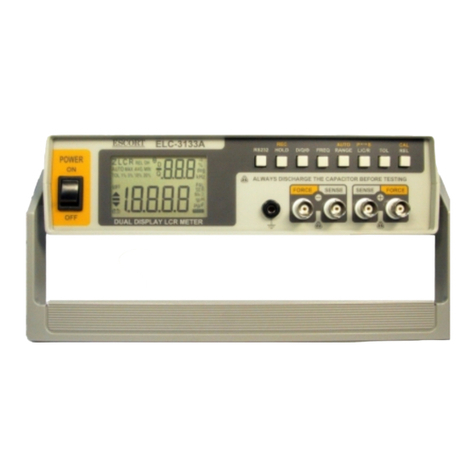
Escort
Escort ELC-3133A quick start guide
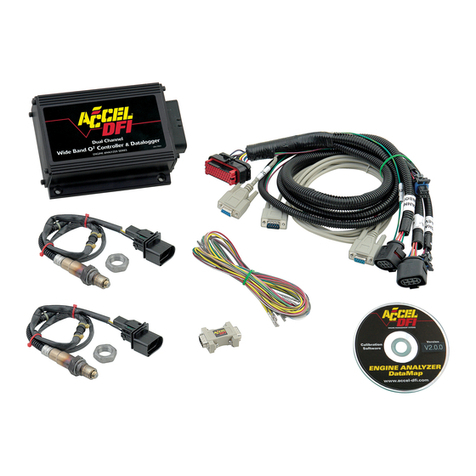
ACCEL DFI
ACCEL DFI Engine Analyzer Series Installation and instruction manual
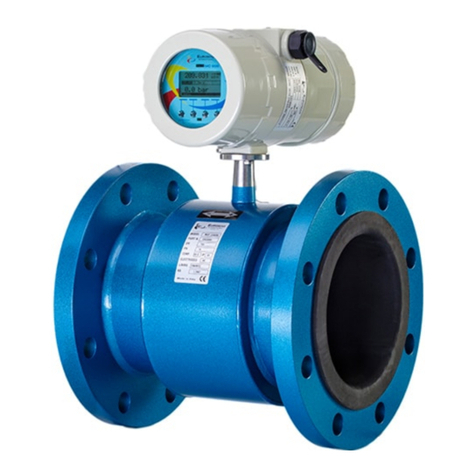
Euromag
Euromag MUT2200EL Quick installation guide

Keysight Technologies
Keysight Technologies 1130B Series user guide

Dickson
Dickson ET8 product manual

CAISSON
CAISSON LVT 15 quick start guide

Clarke
Clarke PGL1 Instructions for use
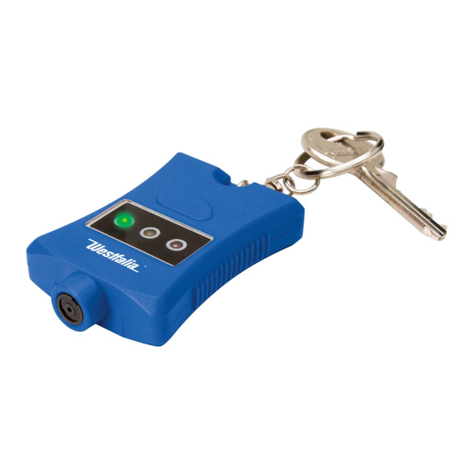
Westfalia
Westfalia 51 21 52 instruction manual

Precision Digital Corporation
Precision Digital Corporation PD6928 instruction manual

AXIOMATIC
AXIOMATIC AX030301 user manual
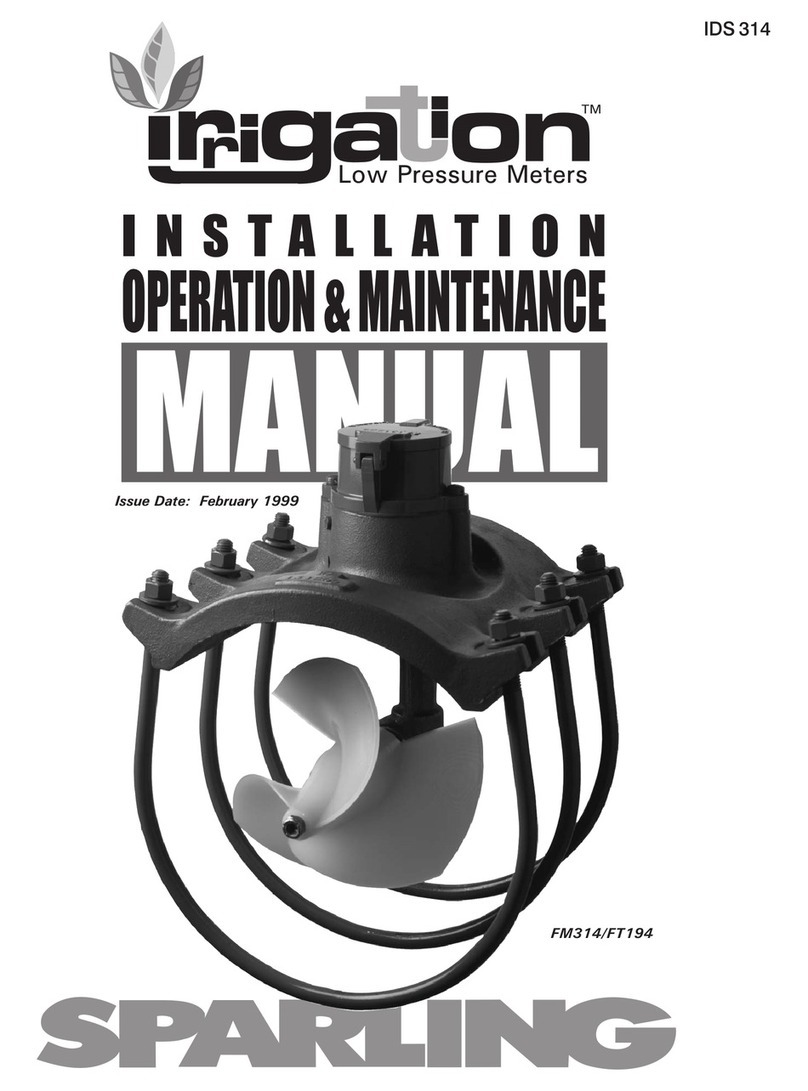
SPARLING
SPARLING Irrigation FM314 Installation, operation & maintenance manual
